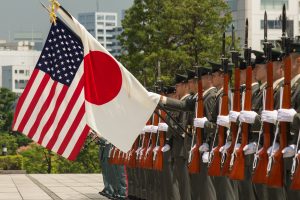By Robert Farley
 At the legal blog Lawfare, Masahiro Kurosaki has a useful account of the legal thinking on how the Japanese Constitution restricts the usage of offensive weapons. This affects not only the types of weapons that Japan can use, but also the tempo and pacing of their use, especially in reference to whether Japan could make an anticipatory response to an attack. This is to say, if the Japanese government obtained near-certain intelligence of an attack upon its territory, could it strike a missile launcher or airfield preemptively, in anticipation of the attack? The answer necessarily has implications for Japan’s ability to acquire “offensive” cruise missiles, as well as the role of reconnaissance and surveillance technology in Japan’s arsenal.
At the legal blog Lawfare, Masahiro Kurosaki has a useful account of the legal thinking on how the Japanese Constitution restricts the usage of offensive weapons. This affects not only the types of weapons that Japan can use, but also the tempo and pacing of their use, especially in reference to whether Japan could make an anticipatory response to an attack. This is to say, if the Japanese government obtained near-certain intelligence of an attack upon its territory, could it strike a missile launcher or airfield preemptively, in anticipation of the attack? The answer necessarily has implications for Japan’s ability to acquire “offensive” cruise missiles, as well as the role of reconnaissance and surveillance technology in Japan’s arsenal.
While some formulations of international law prohibit preemptive attacks, many authorities and learned opinions have been comfortable with a distinction between preemptive war (attacks launched in immediate anticipation of a foreign attack) and preventive war (attacks launched in anticipation of long-range strategic competition).
Any such discussion necessarily involves reference to the notorious “Caroline Affair,” upon which the theory of anticipatory self-defense rests. In December 1837, a Canadian war party burned an American steamer near Niagara Falls, leading Daniel Webster to formulate a legal doctrine for preemptive action to forestall such an attack. Analysts, especially in the United States, have argued that the Caroline Affair opens up wide space for assertive action in response to suspected aggression.
As Kurosaki notes, the practical implications of this theoretical debate come down to questions of posture and force structure on the part of the Japanese Self-Defense Forces (JSDF), as well as the alliance responsibilities of both the United States and Japan. Generally speaking, the responsibilities of the JSDF have been interpreted as tightly as possible in defensive terms, leaving minimal latitude for attacks on foreign soil, and not focusing on capabilities that could be used for such attacks. Nonetheless, both domestic and international arms control efforts have been depressingly weak on the question of “offensive” and “defensive” weapons, probably because nearly any imaginable weapon can have both offensive or defensive uses. A ship can protect itself with a surface-to-air missile system… and it can also use that system to aggressively attack aircraft over another country’s airspace. Indeed, the missiles and launchers used by the United States and Japan in the Aegis Ashore systems are relatively easy to repurpose as land attack cruise missiles. Since its inception, the JSDF has operated aircraft that could easily be used for offensive attacks against nearby foreign targets.
In the event, it is difficult to imagine that Japanese leadership would not use offensive weapons to preempt if Tokyo believed an attack was imminent. As is often the case in the United States, legal debates would provide sufficient smoke to obscure the illegality of what would undoubtedly be a deeply popular decision on the part of the prime minister and the relevant military authorities. Carefully managing the weapons that can strike foreign territory is one way to limit the temptation for Japanese leaders to launch an attack, but growing concern over North Korea, and looming concern over China, may force a reappraisal within Japan of the reach of its offensive military capabilities.
No comments:
Post a Comment